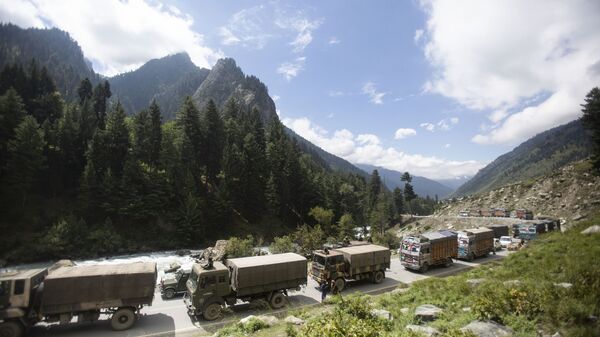With Indian External Affairs Minister underlining that the state of the India-China border cannot be de-linked from the state of the countries' bilateral relationship, the ongoing talks at different levels to address the months-long border stand-off hold a high degree of significance for both sides.
Given their soldiers’ recent clashes along the Line of Actual Control (LAC), India and China have held talks at the military commander level as well as the diplomatic level. Indian External Affairs Minister Jaishankar will be in Moscow on Wednesday, where he is likely to meet China’s Wag Yi.
Though the aim of all talks is to resolve the standoff in Ladakh, analysts feel it’s better to be ready for the long haul in finding a resolution.
The recent engagement at the level of the Indian and Chinese defence ministers in Moscow has also resulted in mere grandstanding by both sides.
According to Professor Swaran Singh, head of the Centre for International Politics at Jawaharlal Nehru University, a premier university in New Delhi, Sino-Indian conflicts in the past have taken prolonged engagements to resolve and the latest ones are no different.
Speaking to Sputnik, he said that in the present context, the existing mannerisms, mechanisms and understandings, both tacit and explicit, have become exhausted.
“If you look at it from that perspective, this engagement or negotiations are not going to resolve the issue very quickly,” Professor Singh told Sputnik, predicting: “It is going to be a painstaking, long-drawn and piecemeal disengagement.”
Professor Singh, an expert on China who observed the recent meeting between the Chinese and Indian Defence Ministers in Moscow on the sidelines of the meeting of the Defence Ministers of the SCO (Shanghai Cooperation Organisation), says it could not have been held without prior preparations.
He says the fact that the two met and talked to each other is an “extremely good sign in a situation like this”.
“This is going to give some face-saving or a breath of life. They might not accelerate the pace of accommodation, but give a little excitement – ‘Let’s start again’,” feels Professor Singh.
It may be noted after the 15-16 June overnight faceoff, in which 20 Indian soldiers were killed, both New Delhi and Beijing began talks at the military commander and diplomatic levels to de-escalate the situation.
In the latest incident, on Monday (7 September), the Chinese army claimed Indian troops had fired shots at its border patrols in the Pangong Tso area, and described the incident as “serious military provocations of a very bad nature”.
New Delhi, however, has denied that its army “transgressed across the LAC (Line of Actual Control) or resorted to use of any aggressive means, including firing”.
According to Dr. Singh, India has been careful in calibrating what differentials can be taken or cannot be taken, and we want to hurt Chinese only to the extent that the message is delivered without pushing it up to the wall.
“In that sense, it is a very symbolic gesture communicating to China, communicating to local constituencies, and of course communicating to Australia, Britain, Canada and the United States ... we are not completely allied with China, we are also doing something,” he says.
“It has multiple purposes, which is the limited calibration of more hyped up messages being sent without any serious economic dent, because that is not the purpose,” he observes.
He says the purpose is “to communicate, rather than beginning to hurt each other” in economic relationships.
India has banned 124 Chinese mobile applications, on the ground that they were engaged in activities “prejudicial to the sovereignty and integrity of India, the defence of India, the security of the state and public order.
According to Brigadier (Retd.) Rumel Dahiya, former Deputy Director General at a Delhi-based government think tank, the Manohar Parrikar Institute of Defence Studies and Analysis, the decision makers in China would have probably taken a gamble and calculated that the Indian government would ultimately somehow end up agreeing to it.
“Now obviously they are in a difficult situation at present. Going back is difficult. After this, probably they will prolong it as long as possible till they find an opening, where they can possibly negotiate a face saving formula,” he opines.
The military veteran, however feels, both sides understand that in terms of their greater interests, a peaceful resolution of the problem was desirable.
He says: “We also don’t want to give them a bloody nose. We simply want them to undo something illegal, something wrong, the breach of trust that they got involved.”
“But they just can’t do that. That’s what we want. We don’t want to fight a war. Getting involved in a conflict is something we would try to avoid unless of course, there is no other way,” he added.
Brigadier Dahiya doesn’t seem very optimistic about the military commander-level meetings or the diplomatic engagements at the current level, in terms of them yielding any results.
He feels: “I think the matters would be solved, that is when would give-them a face saving, only at the level of the Special Representatives or the foreign ministers.”
The military veteran underlined his observations that the resolution of past standoffs had been a long process – the Doklam issue took 73 days, the incursions in Despang Valley in Ladakh in 2013 was reasonably long and the Galvan Valley is going to be the longest.
Nuclear-powered India and China share a 3,500-kilometre (2,175-mile) border, known as the LAC. It stretches from the Ladakh region in the north to the Indian state of Sikkim. In eastern Ladakh, it passes through a lake in the Pangong Tso area.




